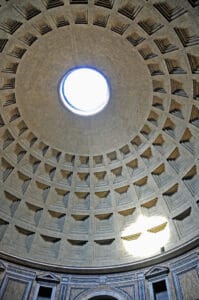The Pantheon: All the Basics You Need to Know
Origins and Historical Context
 The Pantheon is an ancient Roman temple located in Rome, Italy. It was built in the 2nd century AD and has served as a Catholic church since AD 609. The name “Pantheon” comes from the Ancient Greek word Pantheion, meaning “temple of all the gods.” This structure is renowned for its architectural significance and is one of the best-preserved buildings from Ancient Rome.
The Pantheon is an ancient Roman temple located in Rome, Italy. It was built in the 2nd century AD and has served as a Catholic church since AD 609. The name “Pantheon” comes from the Ancient Greek word Pantheion, meaning “temple of all the gods.” This structure is renowned for its architectural significance and is one of the best-preserved buildings from Ancient Rome.
The Pantheon was constructed on the site of an earlier temple commissioned by Marcus Vipsanius Agrippa during the reign of Augustus. The original temple was destroyed by fire, leading to the current building being commissioned by Emperor Hadrian. It is believed that the Pantheon was dedicated around AD 126, although Hadrian chose to inscribe the original date from Agrippa’s temple on the new structure.
In the aftermath of the Battle of Actium, Agrippa initiated a significant building program that included the Pantheon. This structure was part of a larger complex in the Campus Martius, which also featured the Baths of Agrippa and the Basilica of Neptune. The Pantheon was likely a private temple rather than a public one, which may explain the confusion regarding its original name and purpose.
Architectural Design and Engineering
 The architectural design of the Pantheon features a circular rotunda topped by a coffered concrete dome. The dome has a central opening, known as the oculus, which allows natural light to enter. The height of the dome and the diameter of the interior circle are both 43 meters (142 feet), making it a remarkable feat of engineering. The Pantheon remains the largest unreinforced concrete dome in the world, even after nearly two millennia.
The architectural design of the Pantheon features a circular rotunda topped by a coffered concrete dome. The dome has a central opening, known as the oculus, which allows natural light to enter. The height of the dome and the diameter of the interior circle are both 43 meters (142 feet), making it a remarkable feat of engineering. The Pantheon remains the largest unreinforced concrete dome in the world, even after nearly two millennia.
The building is notable for its large portico, which consists of granite Corinthian columns. The portico leads to a rectangular vestibule that connects to the rotunda. The structure’s portico features a series of massive granite columns, each weighing around 60 tons. These columns were transported from Egypt, showcasing the logistical capabilities of the Roman Empire.
The rotunda of the Pantheon is characterized by its dome, which is supported by a series of barrel vaults. The dome’s construction utilized a variety of materials to reduce weight, including lighter aggregates near the top. This innovative design has contributed to the dome’s longevity and stability.
Changes, Restorations, and Continued Use
Archaeological evidence suggests that the current Pantheon was built after Agrippa’s original structure was completely destroyed. The present building’s construction is attributed to Hadrian, although some scholars propose that it may have begun under Emperor Trajan. The exact architectural style of Agrippa’s Pantheon remains uncertain, with various theories regarding its orientation and design.
In 609 AD, the Pantheon was consecrated as a Christian church by Pope Boniface IV. This conversion helped preserve the building during the Middle Ages, as many ancient structures fell into disrepair. The church was dedicated to St. Mary and the Martyrs, and numerous relics were placed within its walls.
Throughout the centuries, the Pantheon has undergone various modifications and restorations. Notably, Pope Urban VIII ordered the removal of the bronze ceiling from the portico in the 17th century. This act, along with other alterations, has led to the loss of some original features, although much of the interior remains intact.
Legacy, Interior, and Cultural Significance
The Pantheon has served as a burial site for several notable figures, including the painter Raphael and the composer Arcangelo Corelli. Its significance as a burial place has continued into modern times, with the tombs of Italian monarchs located within its walls.
Visitors to the Pantheon experience a unique interior space, where the oculus serves as the primary source of light. The floor is designed to facilitate drainage, allowing rainwater to flow out. The interior’s design features a combination of circles and squares, creating a visually striking effect.
In addition to its architectural significance, the Pantheon has influenced numerous buildings throughout history. Its iconic dome and portico design have inspired structures across the world, including the Panthéon in Paris, which mirrors its name and form; Thomas Jefferson’s Rotunda at the University of Virginia; and the U.S. Capitol Building in Washington, D.C., which echoes the grandeur of its dome. Other notable examples include St. Paul’s Cathedral in London and the Low Memorial Library at Columbia University.
Nearby sites

Temple of Hadrian, Rome: An Ancient Roman Monument in the Campus Martius

Domus Romane di Palazzo Valentini

Insula Romana: Ancient Roman Residential Complex in Rome

Trajan’s Column: A Roman Monument in Rome

Theatre of Marcellus
